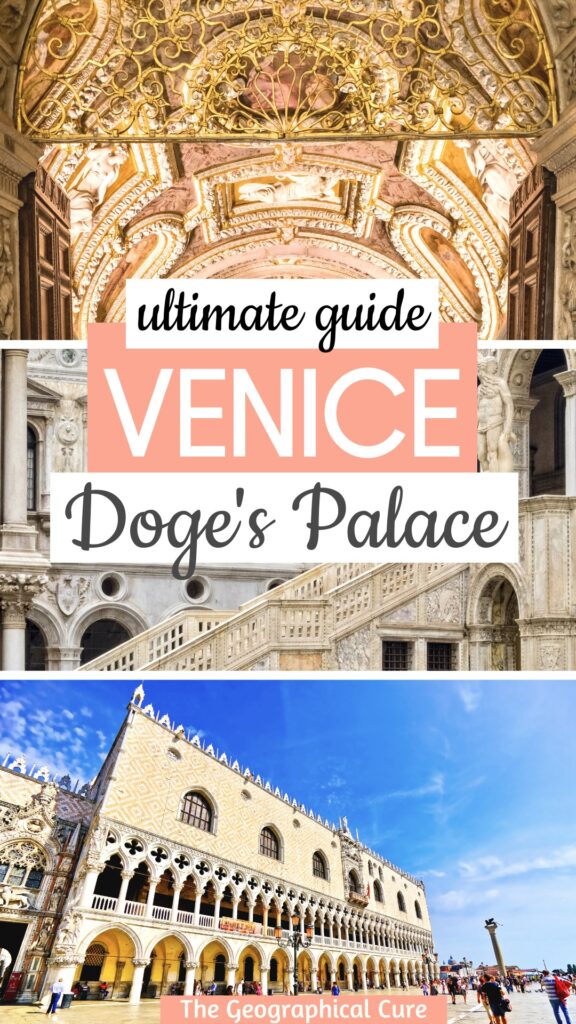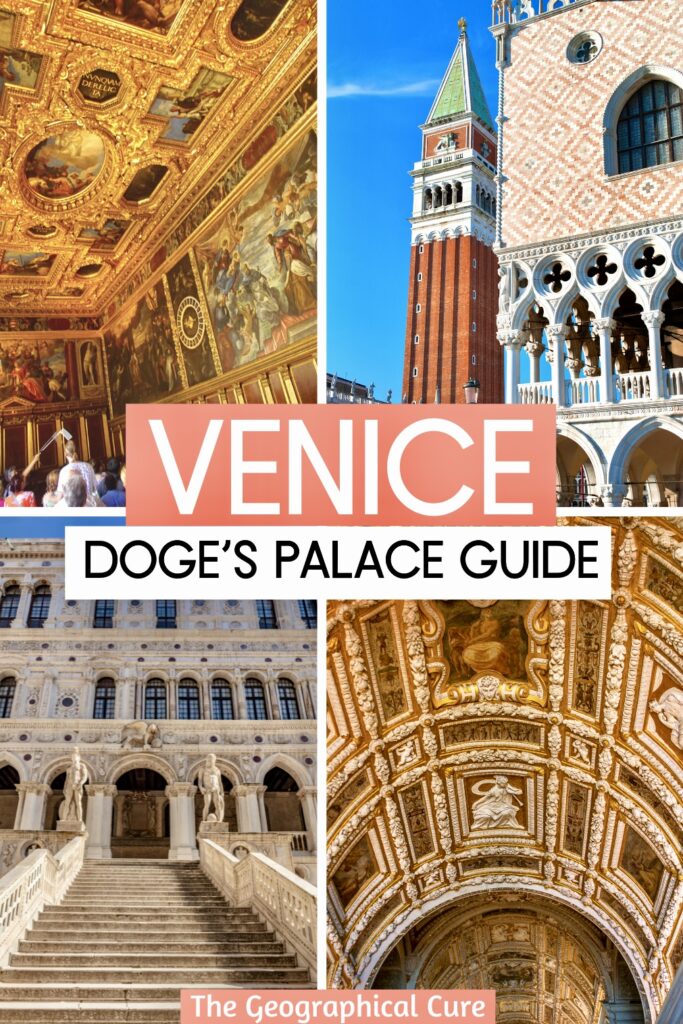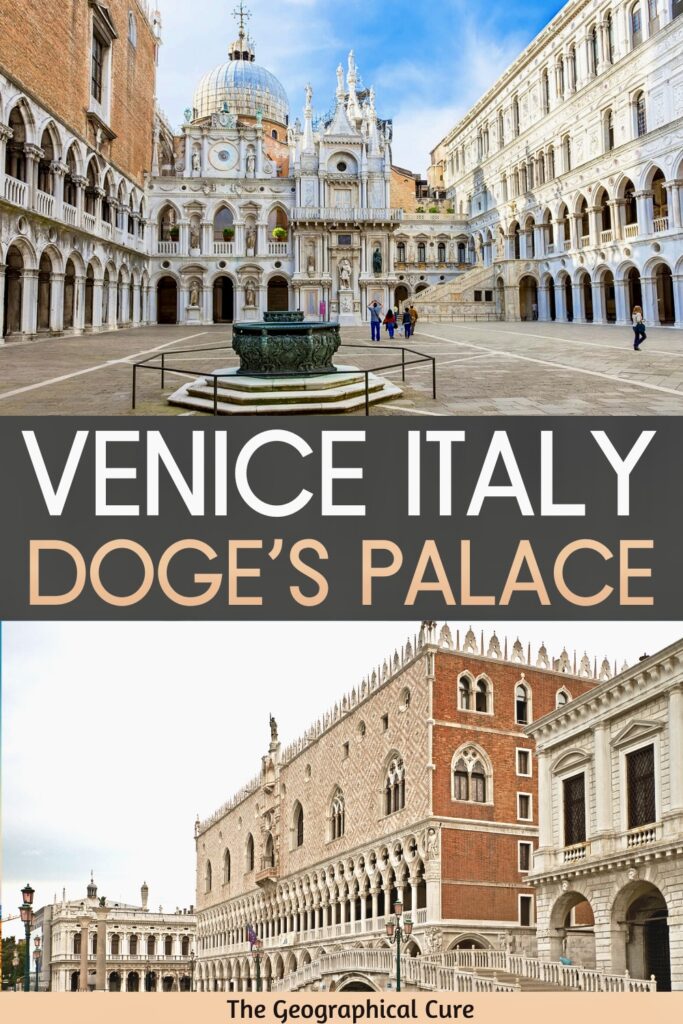Planning a visit to Venice and and looking for a guide to the Doge’s Palace? I’ve got you covered!
For centuries, the Doge’s Palace served as the governmental hub of the Republic of Venice and the residence of the ruling Doge, the elected leader. Behind the pink fairytale exterior, the doges wielded their power and displayed their might.
They also enjoyed opulent living. The lavish decorations and impressive scale were carefully designed to awe and command respect. The greatest artists of the day decorated what seems like acres of walls.
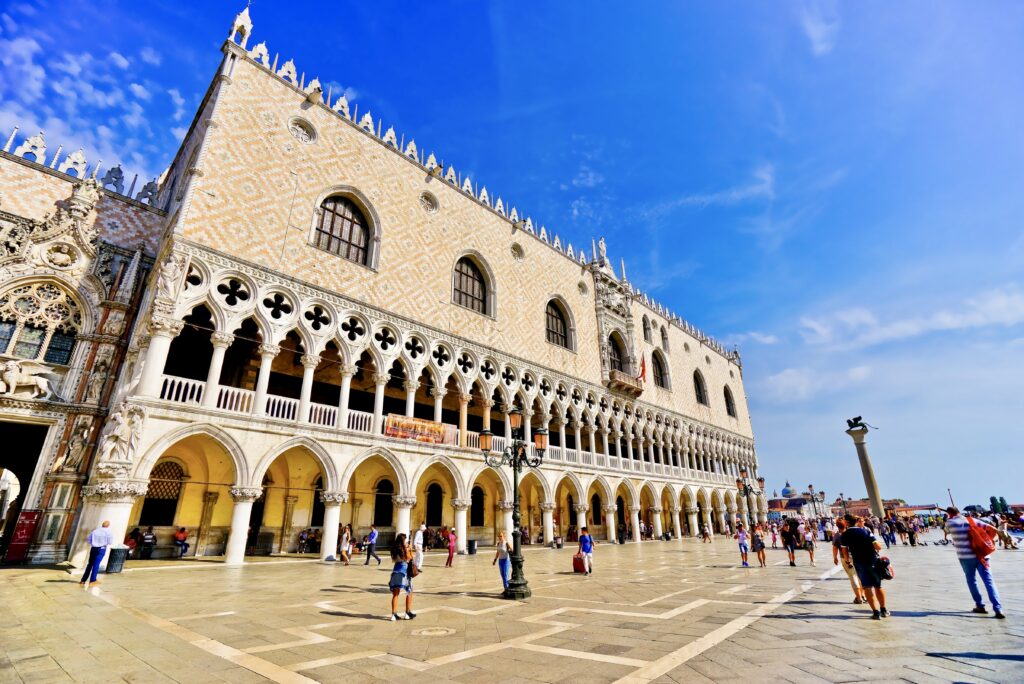
If you were a prisoner, however, the palace’s prison, or piombi, was a place of unspeakable horror. Conditions were harsh and inhospitable, with limited ventilation and extreme temperatures due to the metal roof overhead.
Doge’s Palace At A Glance
Here’s a snapshot of what you can see at the Doge’s Palace:
- facade & courtyard
- Paper Gate
- Giants’ Staricase
- Golden Staircase
- Doge’s apartmentsChamber of the Great Council
- Tintoretto’s Il Paradiso
- Senate Hall
- Collegio
- Chamber of the Council of Ten
- Bridge of Sighs
- Prison
- Casanova’s Cell
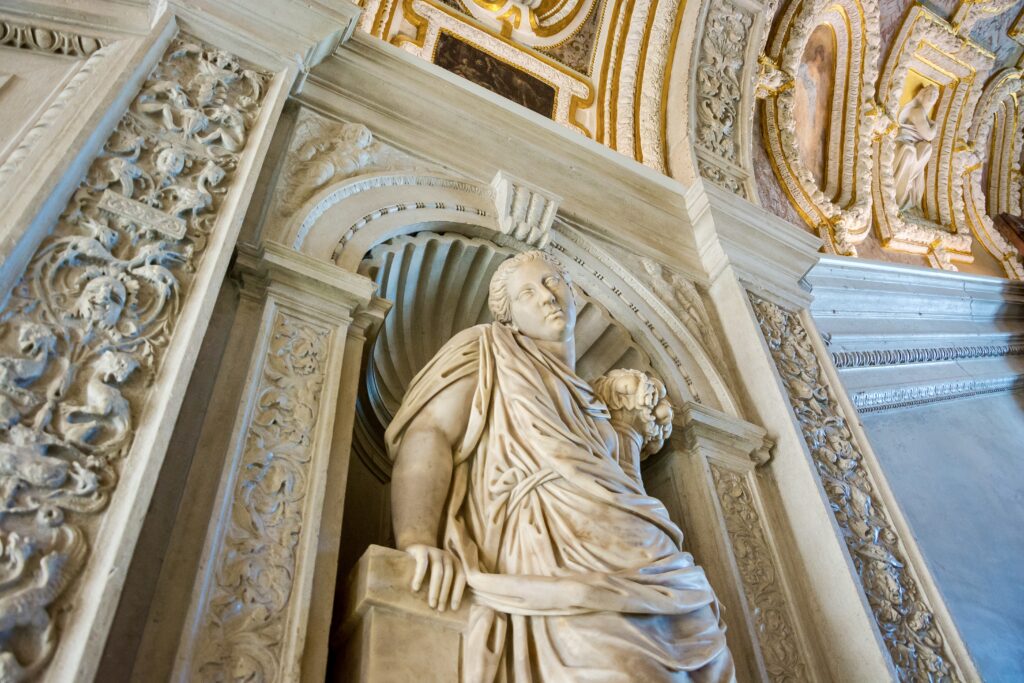
Tickets & Tours
Here are some of the top tickets and experiences you can reserve for the Doge’s Palace. Be sure to book ahead in high season or you could be disappointed.
- skip the line reserved entry ticket
- 2 hour skip the line tour
- VIP secret itineraries tour
- St. Mark’s Basilica + Doge’s Palace tour
- St. Mark’s Basilica, terraces + Doge’s Palace
- 3 hour evening tour of the basilica and palace
You can also buy tickets on the official palace website. But the interface is a bit hard to use.
You can also buy them onsite. But you should expect massive queues if you choose that option.
I recommend getting tickets from a third party seller like Get Your Guide (linked above) or Tiqets instead. Admission is also included with the St. Mark’s City Pass, the Venice Pass, or the Venice Discovery Pass.
If you’re a history buff, I highly recommend booking the Secret Itineraries Tour.
It’s a specialized tour that gives you access to areas of the palace that aren’t included in the standard admission ticket. You’ll have an unparalleled look into the secret inner workings of the Venetian state.
The tour takes you to the stark rooms that were once used by the Venetian government’s intelligence operations — hidden chambers, corridors, prisons, and torture chambers.
You’ll learn about the political intrigues, espionage, and secret dealings, and methods of surveillance and control that were employed by the Venetian authorities.
If you don’t like crowds, consider booking the evening tour. It’s more expensive, but you’ll have more elbow room.
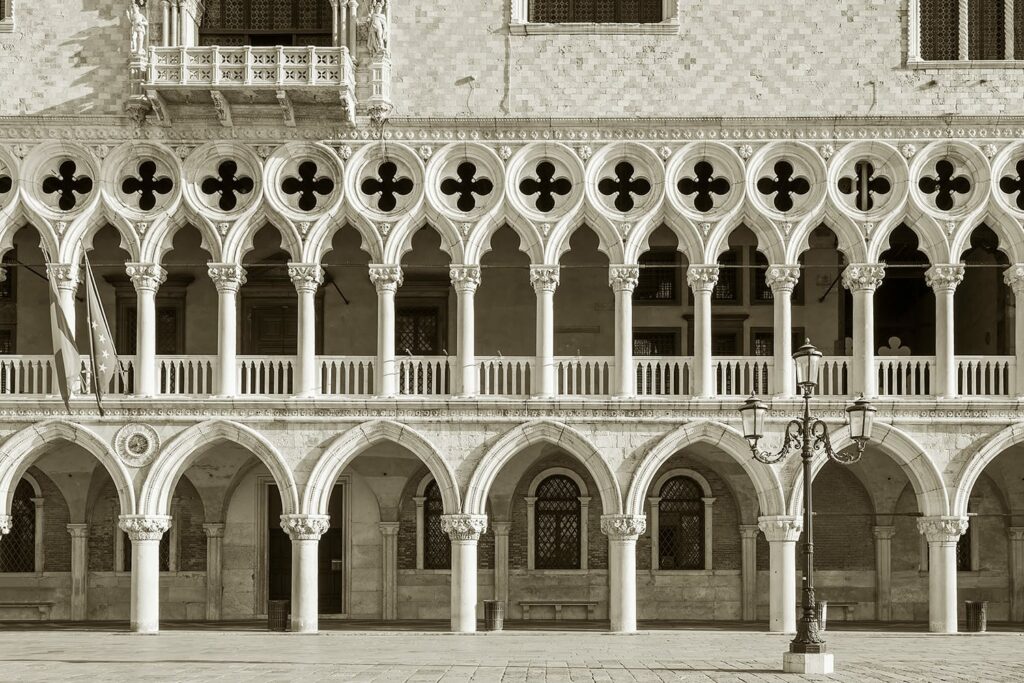
Guide To The Doge’s Palace: What To See
Here are the highlights and things you can see on a visit to the Doge’s Palace.
1. Facade
The facade of the Doge’s Palace in Venice is primarily made of white and pink Istrian stone from Croatia.
The first level of the facade has an open arcade of simple Gothic arches. The second has an enclosed loggia with ornate arcading and tracery. The top floor is a solid wall broken by a sequence of Gothic windows.
The facade on the piazza side was built in the 15th century as a continuation of the 14th century waterfront facade.
On the corner by the bridge is an exquisite marble relief carving, the Drunkenness of Noah. On the corner by the piazza, is a relief sculpture of Adam and Eve from the late 14th century.
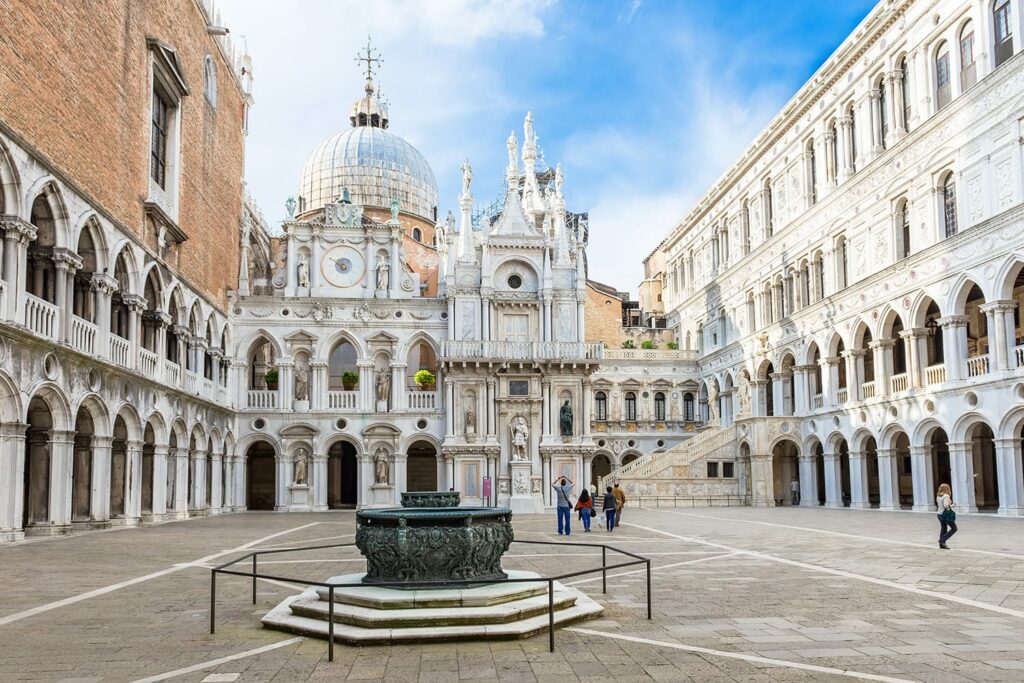
2. Courtyard
The courtyard is a magnificent open space surrounded by impressive Gothic architecture and adorned with sculptures. It served as a grand entrance and a focal point, providing access to various sections of the palace.
The courtyard is surrounded by two lower levels of arched arcades, each adorned with delicate tracery, intricate ornamentation, and sculptural details. The columns, arches, and decorative elements create a harmonious interplay of light and shadow.
At the center of the courtyard, you’ll find a well. It’s a functional element that once served as a water source for the palace’s inhabitants. This well is adorned with a remarkable sculptural composition depicting Neptune, the Roman god of the sea, surrounded by mythological figures.
The Arco dei Foscari in the courtyard is a late Gothic work, commissioned by Doge Francesco Foscari in 1438. It was built by Antonio Bregno and Antonio Rizzo.
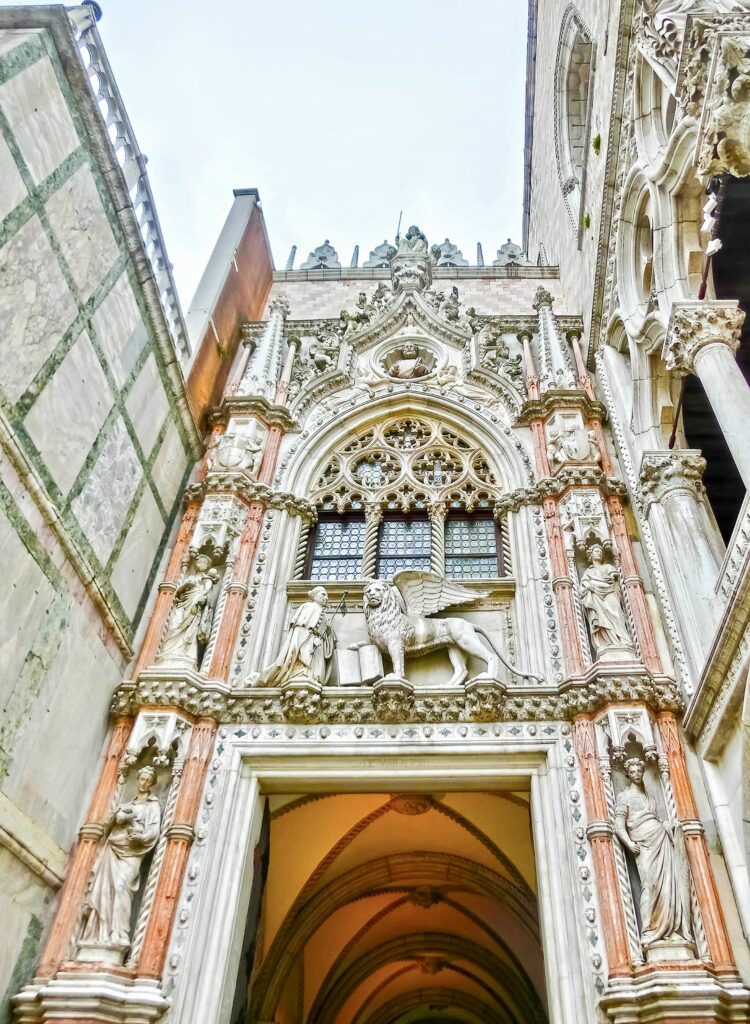
3. Paper Gate
The Paper Gate, also known as the Porta della Carta in Italian, is an intricately designed entrance gate in the courtyard. It was designed by Bartolomeo Bon.
The gate served as the main entrance from the courtyard into the palace’s public chambers. This was where permits were checked.
The gate is a rather grand and florid piece of late Venetian Gothic architecture. It features ornate decorations, sculptures, reliefs, and delicate tracery.
There sculptures in the center are of Doge Francesco Foscari and the winged lion of St. Mark, which is a symbol of the city. They’re copies, as the originals were destroyed by the French in 1797.
St. Mark himself is above them in a circular frame supported by two angels. In the side niches are sculptures of the Virtues.
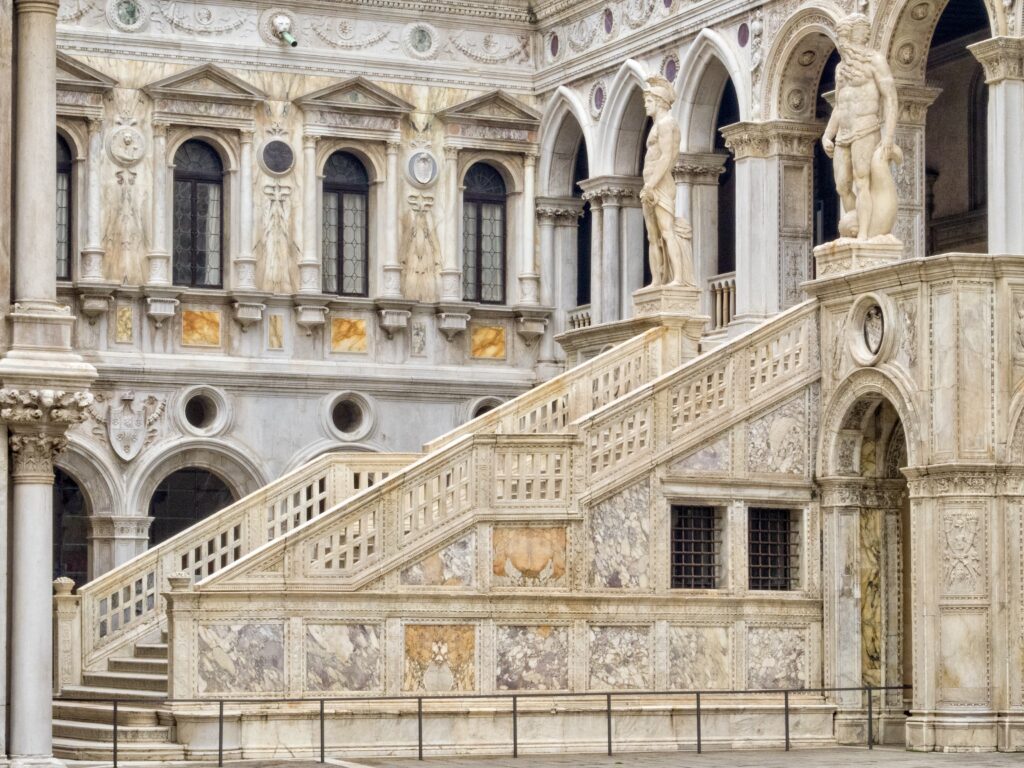
4. Giants’ Staircase
Architect Antonio Rizzo designed and oversaw the building of the monumental Giants’ Staircase between 1485 and 1491.
The staircase served as a ceremonial entrance for important state events, official receptions, and significant occasions. This was also where the doges were crowned.
It features a wide central staircase with two smaller lateral staircases that lead to a spacious landing. The staircase is flanked by colossal statues of Mars and Neptune (the “giants”).
They were sculpted by Jacopo Sansovino. They symbolize Venetian power on land and sea.
This staircase leads to the upper level of the palace and serves as the main entrance for visitors.
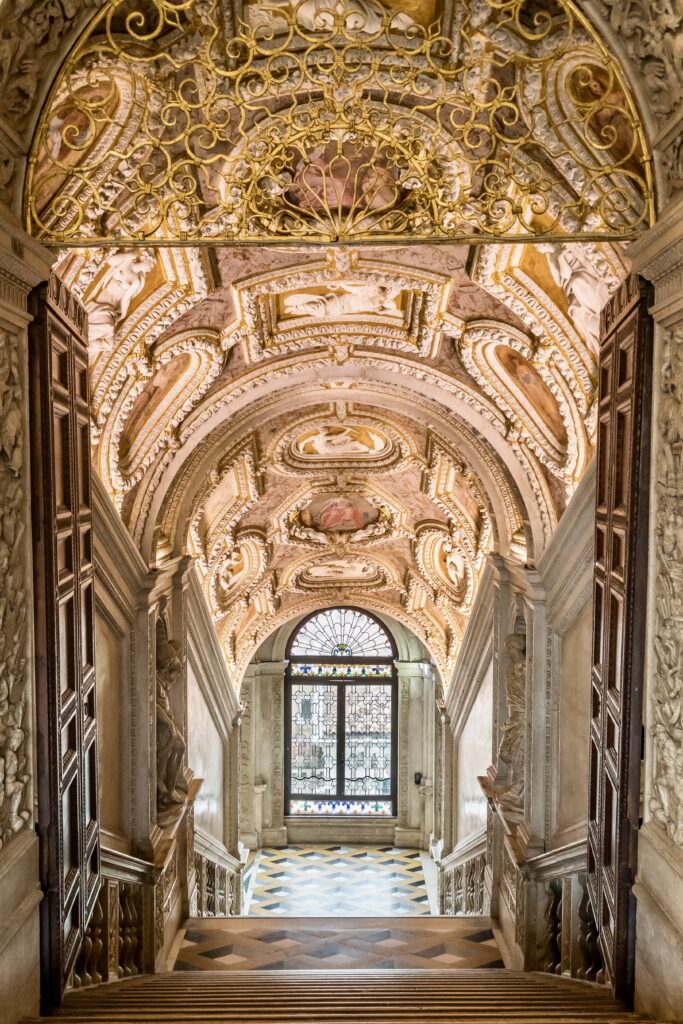
5. Golden Staircase
Venture inside on the Golden Staircase, Scala d’Oro, one of the world’s most richly decorated staircases.
The staircase serves as a pathway that connects the ground floor of the palace to the upper floors. It’s so named because of its lavish gold leaf decoration, ornamental balustrades, railings, and sculptures. 24K gold was used!
The staircase is a prime example of Renaissance and Venetian Gothic architectural styles, featuring delicate tracery, detailed sculptures, and elegant arches. The balustrades are adorned with sculptures of allegorical figures, mythological beings, and intricate motifs that reflect Venice’s cultural heritage.
One of the prominent frescoes on the ceiling of the Golden Staircase is the Triumph of Venice by Nicolo Bambini. This scene portrays Venice as a triumphant and powerful city, surrounded by allegorical figures representing victory, prosperity, and maritime prowess.
This extraordinary staircase offers two views: one of the majestic courtyard of the Doge’s Palace and another of the Bridge of Sighs.
6. Doge’s Apartments
The Doge’s Apartments are on the first floor. They were the private living quarters of the Doge, the highest-ranking official and leader of the Venetian Republic.
They were destroyed by fire in 1483 and entirely rebuilt in a Renaissance style.
The apartments are notable for their intricately engraved wooden ceilings, grand marble chimneys adorned with exquisite and delicate carved ornamentation, painted friezes, and stucco embellishments.
7. Chamber of the Great Council
The Chamber of the Great Council is the largest room in the palace and one of the most impressive spaces you’ll see in all of Europe. This was where the Great Council met.
The room is (and was) a marvel of artistry. Before the fire of 1577, the rooms were decorated by Bellini, Titian, Gentile da Fabriano, and Carpaccio.
Now, somewhat less illustrious painted panels decorate the ceiling. But among them is the gorgeous Apotheosis of Venice. It’s a painting by Paolo Veronese, dating from 1585.
Just below the ceiling is a captivating gallery. A mesmerizing parade of portraits line the walls, depicting the first 76 doges of Venice.
The later portraits are found in the Sala dello Scrutinio. They were completed by Domenico Tintoretto, Tintoretto’s son, and his workshop. The one of Doge Marin Falier was blacked out when he was convicted of treason and beheaded.
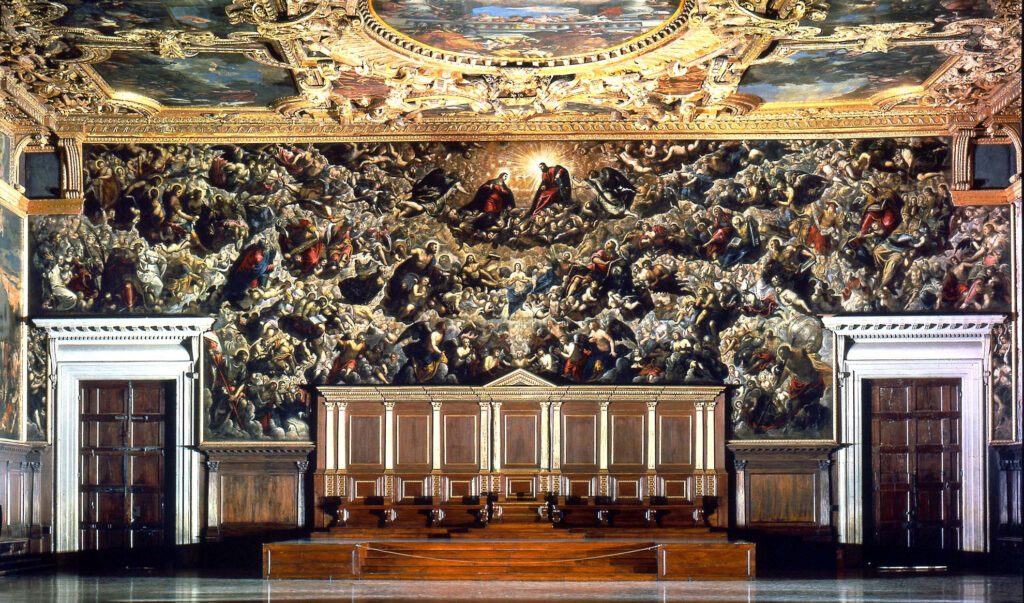
8. Il Paradiso
However, the spectacle doesn’t end with the ceiling or the portraits. You can also admire Tintoretto’s Il Paradiso on a wall in the Great Council Chamber.
It holds the distinction of being the world’s largest canvas painting. It’s approximately 80 feet long and 32 feet high.
Tintoretto was undeniably a product of Venice, his birthplace and final resting ground. He was a ferociously ambitious man who competed with the esteemed Titian and the emerging Veronese.
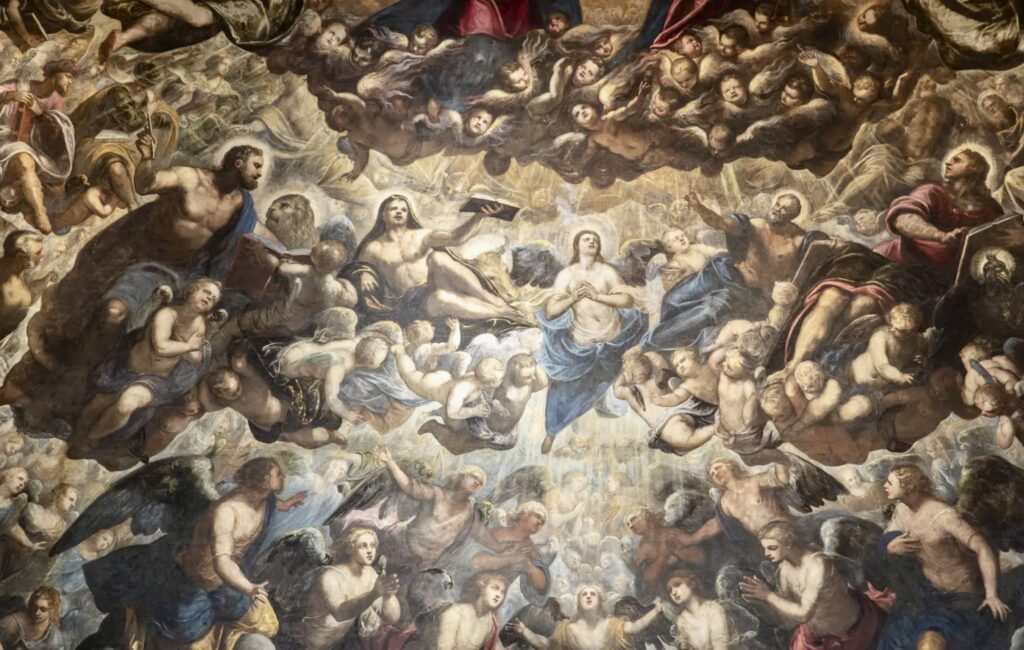
His work is known for its earthy intensity, unconventional perspectives, fast and furious brush strokes, and dramatic dark and light contrasts.
Interestingly, Tintoretto was 70 at the time he painted Il Paradiso. Veronese had won the commission, but died before he finished his initial sketches.
Tintoretto was assisted by his son Domenico. He needed help climbing and descending the scaffolding. Because of this, there are slight differences in the representation of some characters.
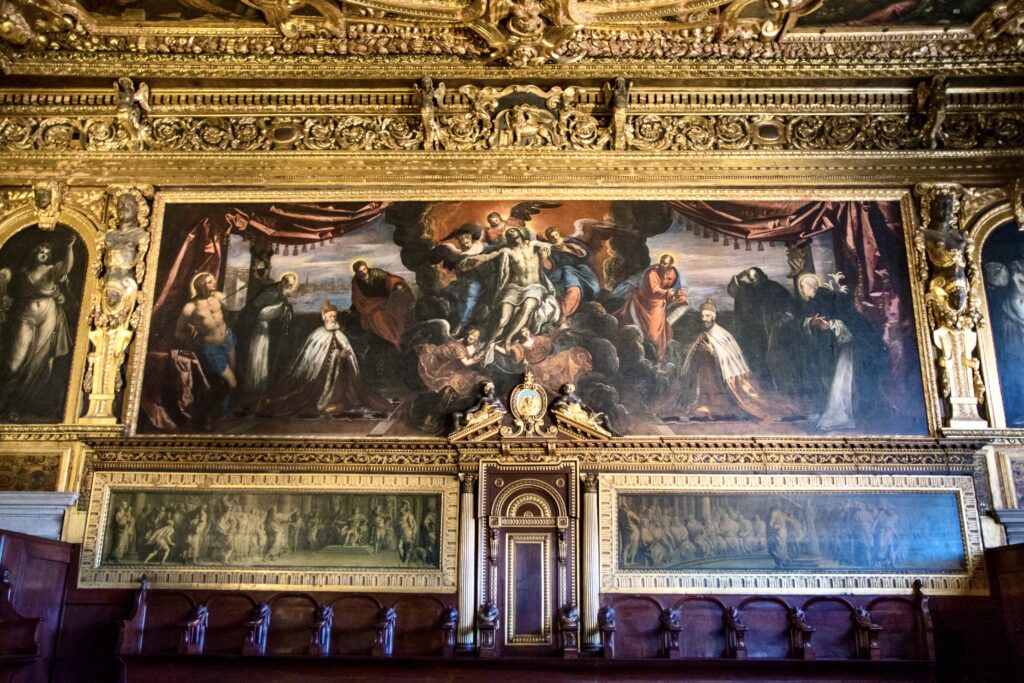
9. Senate Hall | Sala dello Scrutinio
This expansive chamber was built between the 1520s and 1540s. Originally designated as the Library, it housed precious manuscripts gifted by Petrarch and Bessarione in 1468.
Eventually, the hall became a space for electoral processes and deliberations central to Venetian politics. This is where the senate debated questions of foreign policy, war, and commerce. And where votes were counted.
The rich ceiling was designed by painter-cartographer Cristoforo Sorte. It depicts military history scenes celebrating Venetian triumphs, including the conquest of the maritime empire.
Tintoretto’s ceiling painting, The Triumph of Venice, is in the center. Like others, it’s a propaganda work glorifying the power and wealth of Venice during its Golden Age.
On the walls, there are depictions of battle victories from 809 to 1656. Andrea Vicentino’s The Battle of Lepanto of 1571 is the standout.
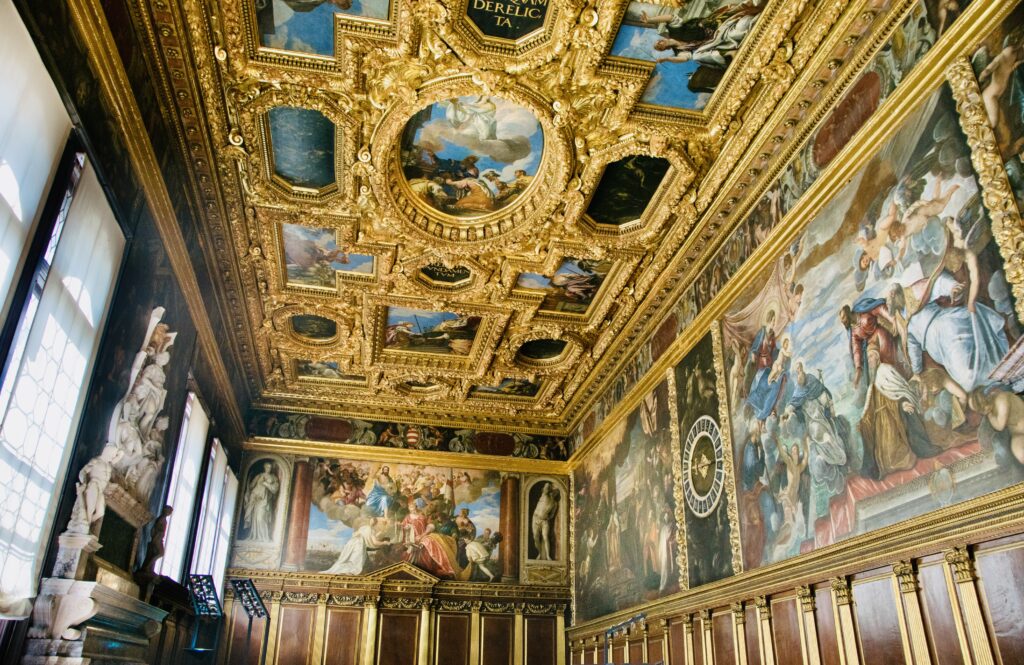
10. The Collegio
The Sala del Collegio, also known as the Hall of the College, is one of the most splendid rooms in the palace. It was the antechamber to the Great Council Chamber and boasts a spectacular cycle of ceiling paintings.
The hall served as a venue for important meetings and ceremonies of the Venetian Republic’s governing body. The room’s decoration reflects the grandeur and authority of Venice during its heyday.
Paolo Veronese’s artistic brilliance is on full display here. The central fresco shows Venice distributing awards and honors.
An ornate frieze encircles the walls. Next to the doorways are four canvases by Tintoretto depicting mythological scenes.
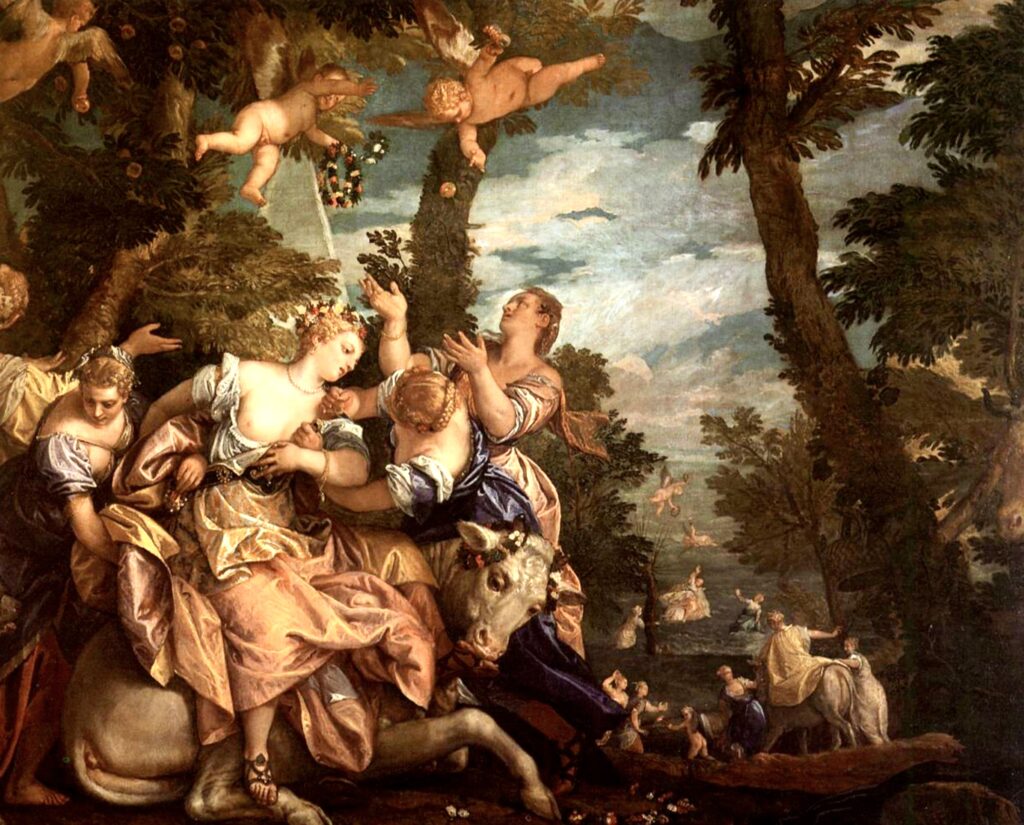
11. Anticollegio
The anticollegio was the ambassadorial waiting room.
It’s covered with four works by Tintoretto, including Mercury and the Three Graces and Bacchus and Ariadne. The latter is considered one of the artist’s better works.
Another must see is Veronese’s splendid Rape of Europa. Most art historians consider it the finest painting in the palace.
It depicts the mythological tale of Europa’s abduction by Jupiter in the form of a bull.
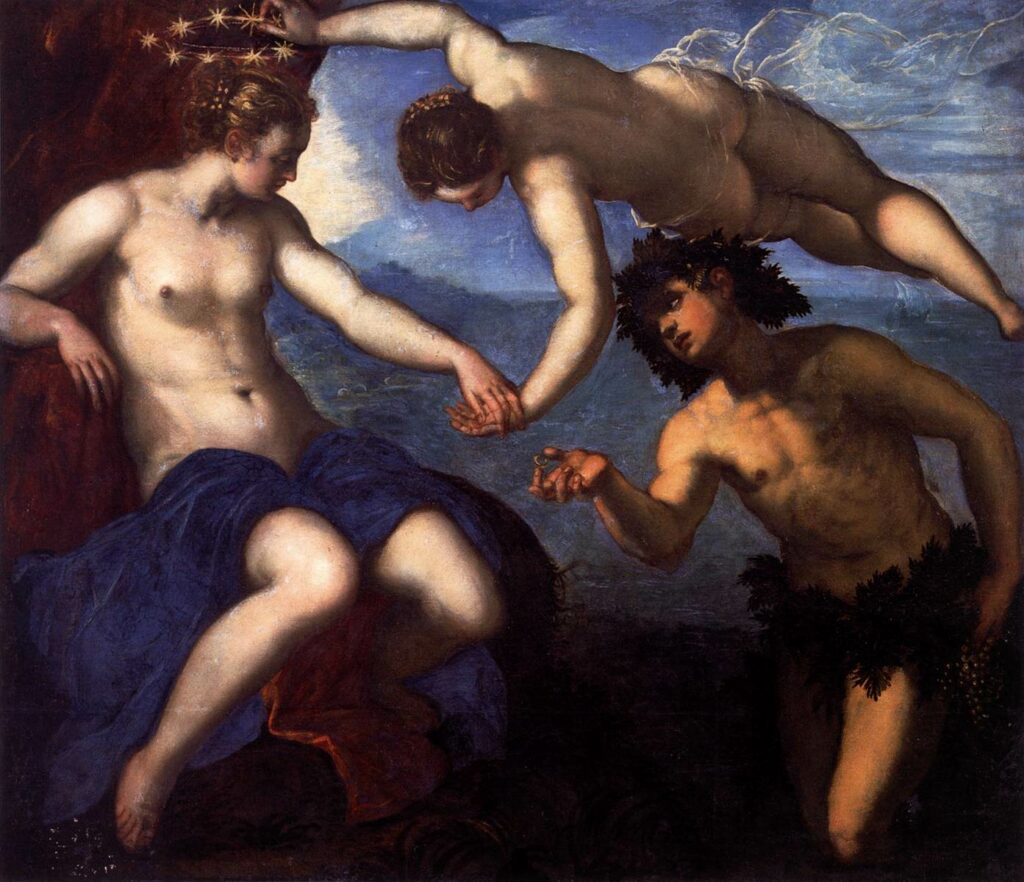
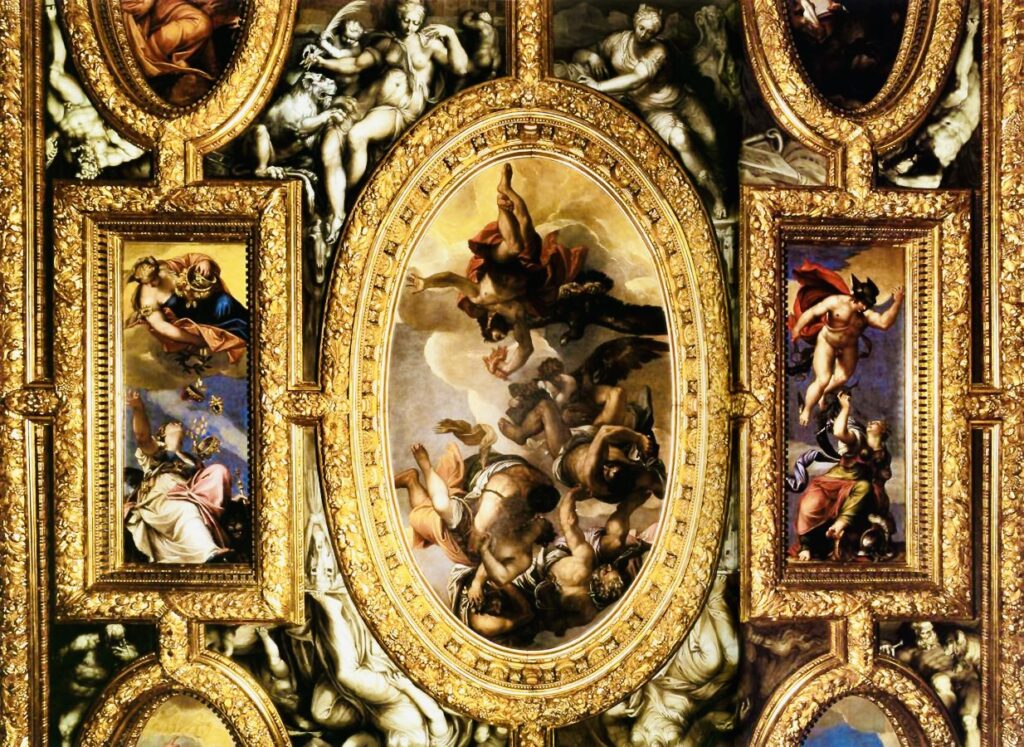
12. Chamber of the Council Of Ten
This is another beautiful room, home to the Council of Ten, the Sala del Consiglio dei Dieci. They were ten members chosen from the Senate and elected by the Great Council who served as a check on the doge.
The council dispensed justice, including decapitations. Its authority covered all aspects of public life. This broad range of powers gave rise to the legend that it was a ruthless oligarchy, handing down edicts in secret councils.
The central ceiling canvas was painted by a young Veronese in 1554-56. It depicts Jupiter Striking Down the Vices. This is actually a copy; the original was carried off by Napoleon and is in the Louvre.
To the left is another Veronese, Juno Showering Gifts on Venice.
Another must see painting is Titian’s Judith and Holofernes. It’s a popular theme that portrays the biblical story of Judith beheading the Assyrian general Holofernes.
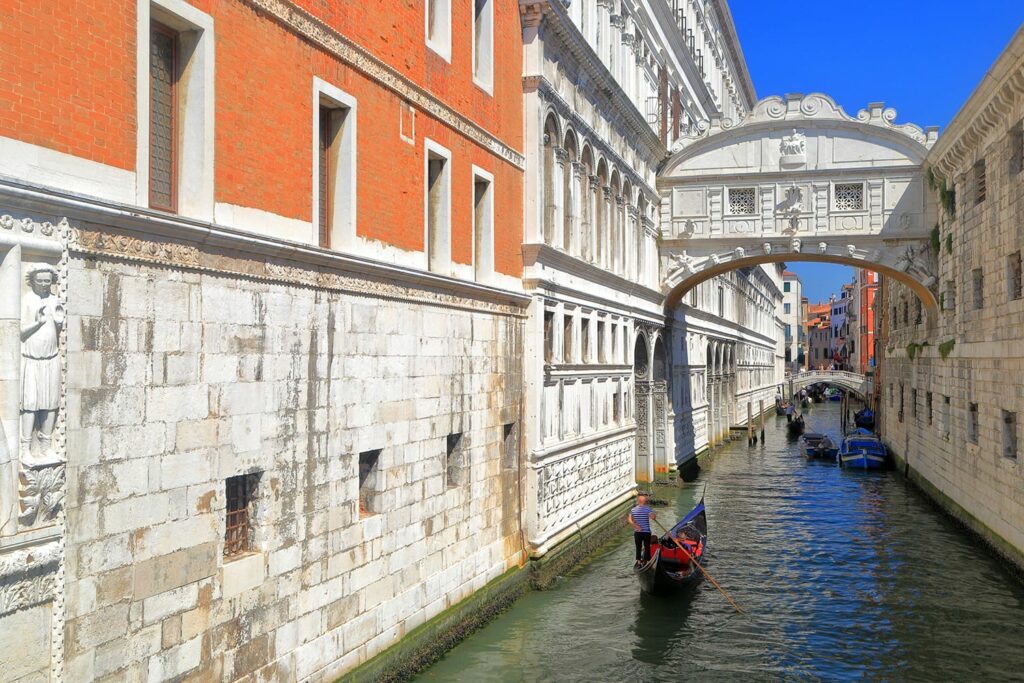
13. Bridge of Sighs & Prison
The Bridge of Sighs connects the Doge’s Palace to the New Prisons. It has a storied history linked to the passage of prisoners between the courtroom in the palace and the prisons across the canal.
The bridge’s name originates from a myth that prisoners would sigh as they caught their last glimpse of the outside world before entering confinement.
During a regular tour of the Doge’s Palace, you’ll likely have the opportunity to see the Bridge of Sighs from both the interior of the palace and the exterior. But you won’t cross it unless you’re on a special tour.
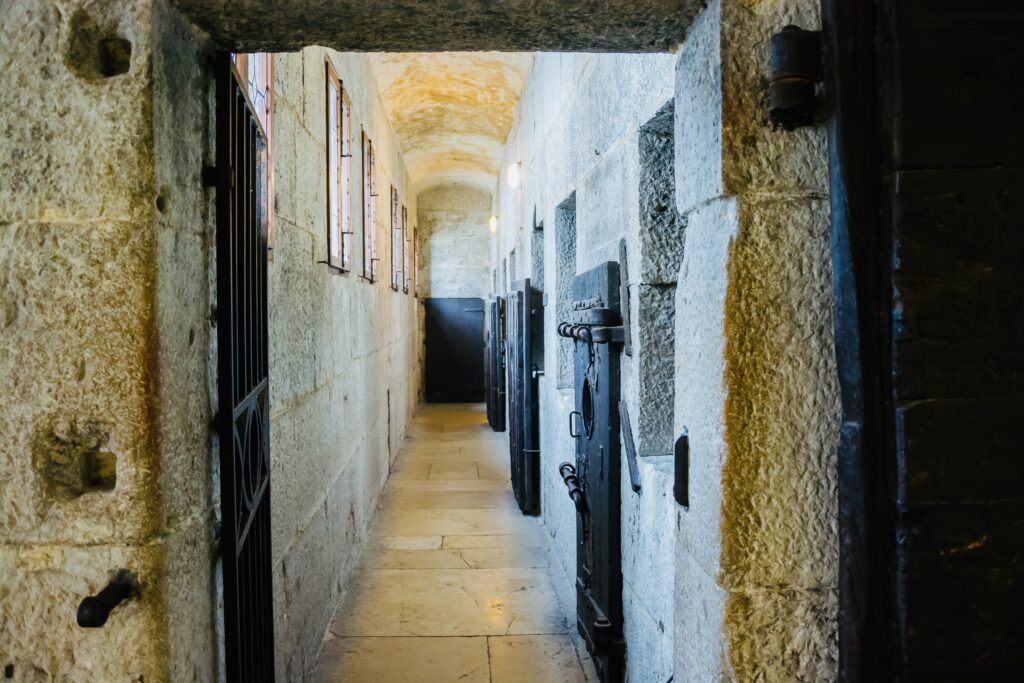
The prisons were located in the attic under the palace’s lead roof. The dungeons were primarily used to detain political prisoners and individuals accused of treason or plotting against the Venetian Republic.
Prisoners endured cramped spaces and isolation, often subjected to darkness and dampness. You can still see some graffiti on the dungeon walls.
One room was called the Chamber of Torment. A prisoner would wait in complete darkness to be questioned. He would be inundated with fake screams, intended to raise the terror level.
You’ll want to examine Casanova’s cell. It’s famous due to his allegedly daring escape from captivity.
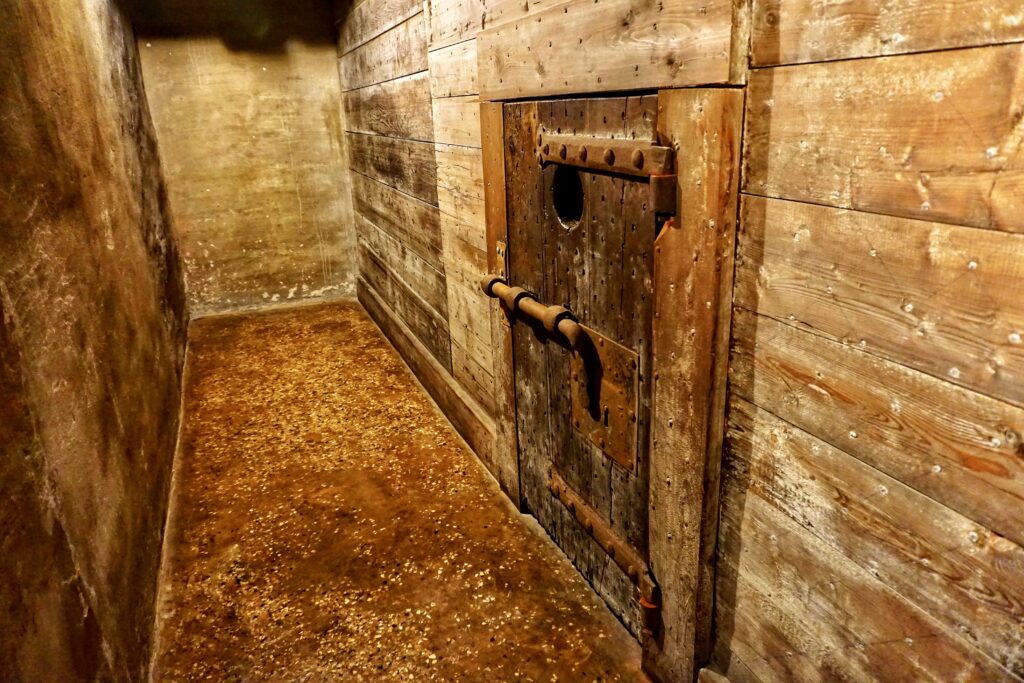
Giacomo Casanova was a Venetian adventurer, writer, and notorious figure known for his escapades and romantic conquests.
Casanova was arrested in 1755 and imprisoned. His escape in 1756 is a tale that became part of his legend.
The story goes that he managed to escape by manipulating the guards and using his intelligence and charm to his advantage.
Some stories say he convinced a fellow prisoner to lend him some priestly attire and used his knowledge of the layout of the palace to navigate through a series of locked doors and hidden passageways.
Other accounts suggest that he climbed through a small window in his cell and made his way across the rooftops to reach freedom. Most likely, he just bribed a guard.
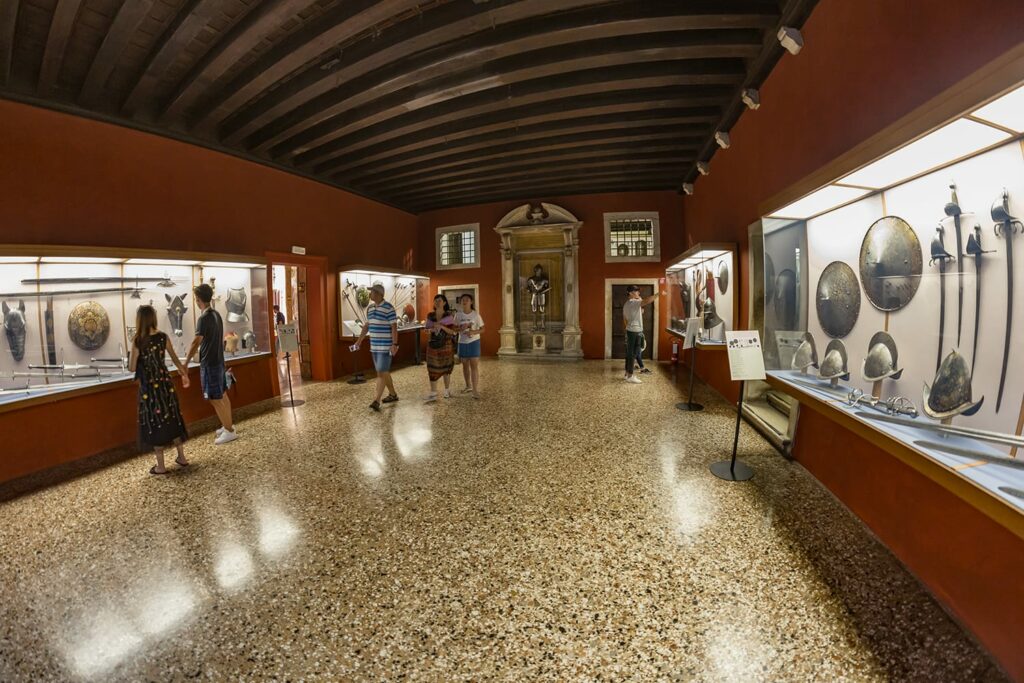
14. Museo dell’Opera
The entrance to the museum is just to the left of the ticket barrier. There are six rooms to explore, with mostly assorted bits from the palace facade.
Room I exhibits carved 14th century capitals and columns showcasing diverse world views. The capitals in Room II depict moral themes. Room III features a standout corner capital with the Creation of Adam.
Room IV offers insight with ancient wall blocks. In Room V, intricate stonework, including Gothic elements, stands out.
The largest room, Room VI, displays diverse groups of 26 capitals from the first floor loggias.
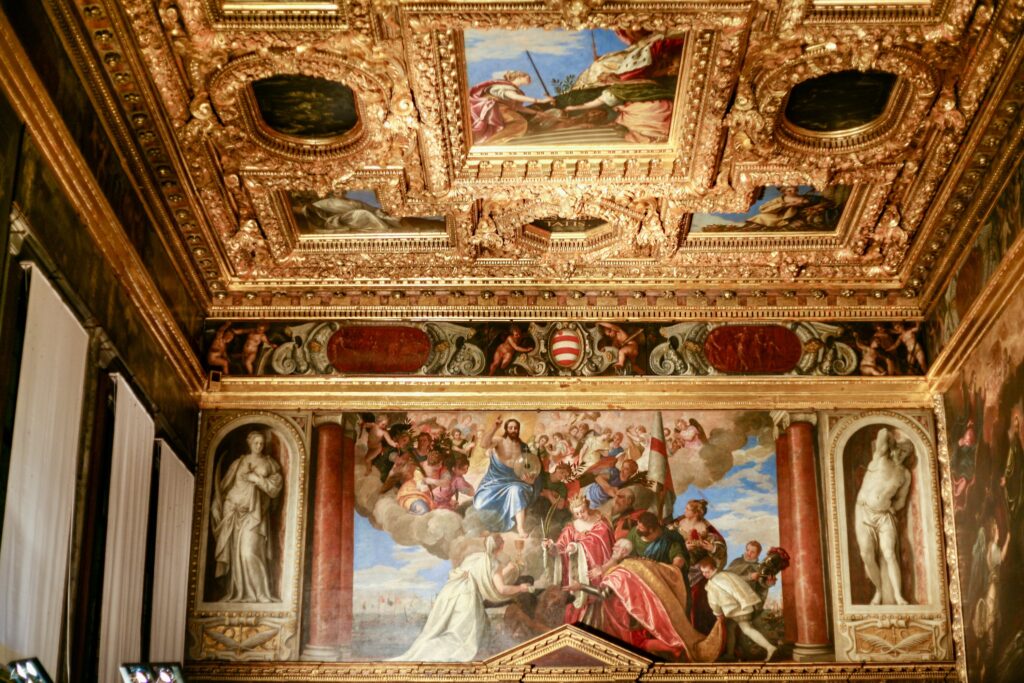
Practical Guide & Tips For The Diego’s Palace
No guide to the Doge’s Palace is complete without some must know tips for visiting.
1. Getting There
The Doge’s Palace is located in St. Mark’s Square (Piazza San Marco), which is a central landmark in Venice. You can easily reach it by walking from various points in the city or by taking a vaporetto (water bus) to the San Zaccaria stop.
The public entrance is through the Porta del Fermento under the waterfront facade.
2. Tickets and Reservations
The standard ticket price is 13 euros. It’s highly recommended to book your tickets in advance, especially during peak tourist seasons.
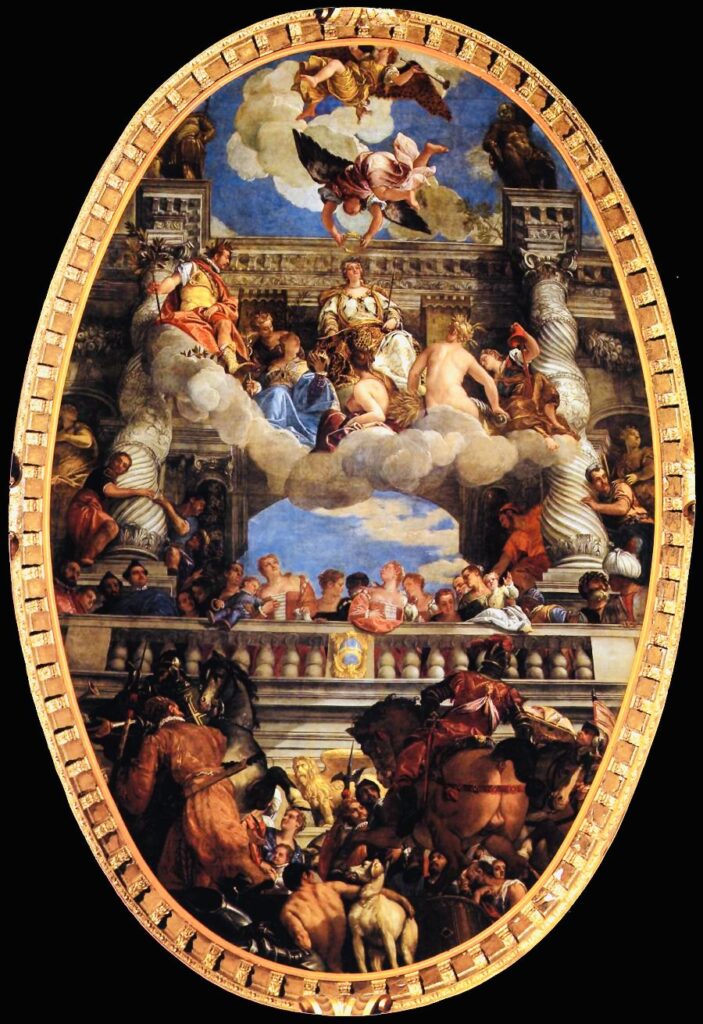
You can purchase tickets online through the official website of the Doge’s Palace. Or buy skip the line tickets on Get Your Guide or Tiqets.
3. Hours
The palace is open every day from 9:00 am to 7:00 pm. The last entrance is at 6:00 pm.
4. Security Check
Like many historical sites, the Doge’s Palace has security checks. Arrive a bit early to allow time for security procedures.
Avoid carrying large bags or prohibited items to expedite the process. Security measures may include bag checks and metal detectors.
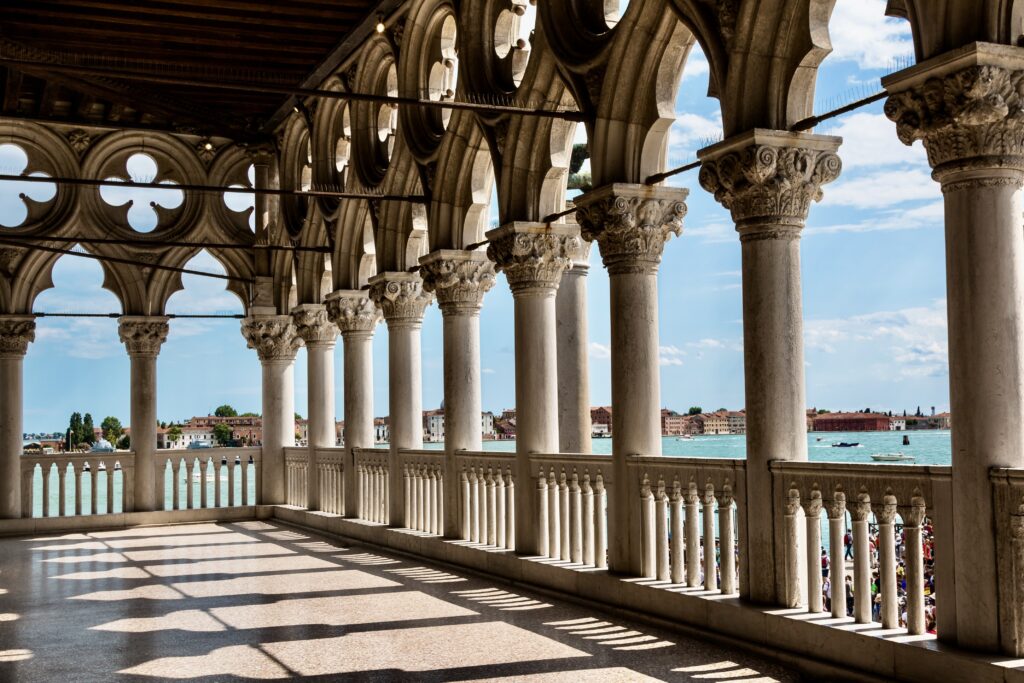
5. Guided Tours
As I mentioned above, you might consider joining a guided tour to enhance your experience. Guided tours often provide insights into the history, architecture, and art of the palace, enriching your visit. Most tours also give you skip-the-line access, saving you time.
6. Audioguides
If you prefer to explore independently, consider renting an audioguide at the palace. Audioguides provide informative commentary about the palace’s history, architecture, and the artworks you’ll encounter.
7. How To Budget Your Time
I would budget 2-3 hours to see the palace. Plan your route through the palace strategically. Here’s an approximation of how much time you could allot for each site:
- Entry and Security Check (15 minutes)
- Courtyard and Giant’s Staircase (15-20 minutes)
- Doge’s Apartments (30 minutes)
- Chamber of the Great Council (15 minutes)
- Senate Hall and Council of Ten (15 minutes)
- Collegio and Anticollegio (15 minutes)
- Bridge of Sighs and Prisons (30 minutes)
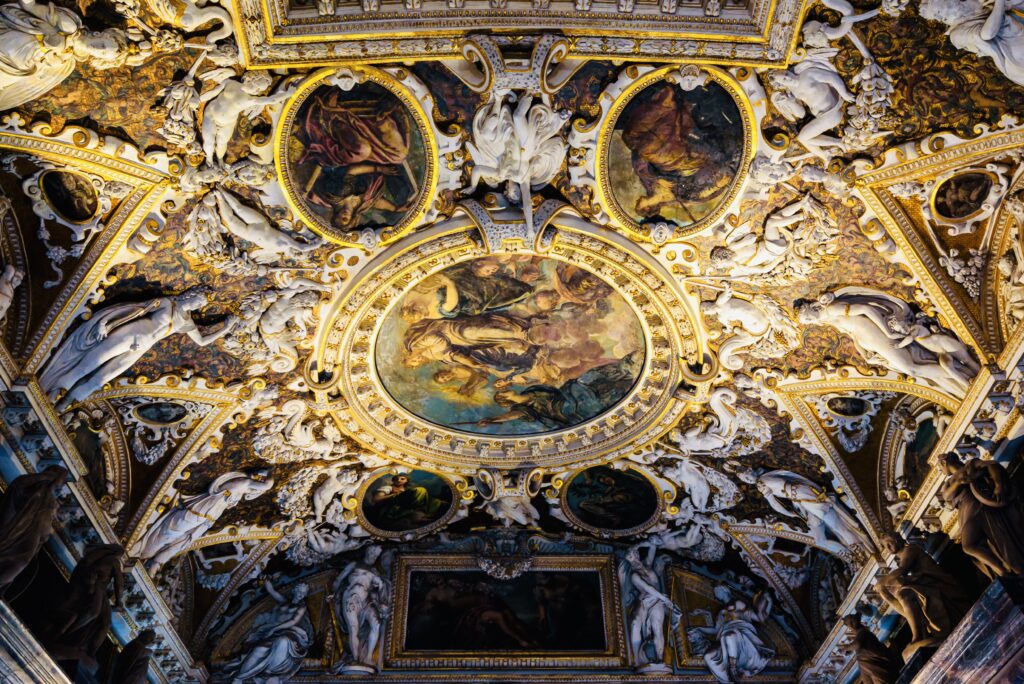
8. Photography
Photography without flash is generally allowed in most parts of the palace. But it’s always a good idea to check on-site rules and respect any areas where photography might be restricted.
9. Timing: When To Visit
Try to visit the Doge’s Palace early in the day or later in the afternoon to avoid the peak crowds.
10. Is the Doge’s Palace Worth Visiting?
100% yes.
As one of Venice’s most iconic landmarks, the palace offers a remarkable journey through history, art, and culture of Venice. Art lovers will want to visit just for the Renaissance masterpieces by Tintoretto, Veronese, and Titian.
I hope you’ve enjoyed my guide to the Doge’s Palace. You may enjoy these other Venice travel guides and resources:
- One day in Venice itinerary
- 2 days in Venice itinerary
- Guide to the Accademia Gallery
- Top Attractions on the Grand Canal
- Guide to the Peggy Guggenheim Collection
- Venice art bucket list
- How many days to spend in Venice?
- 30+ tips for visiting Venice
- Guide to the Frari Church
If you need a guide to the Doge’s Palace, pin it for later.

